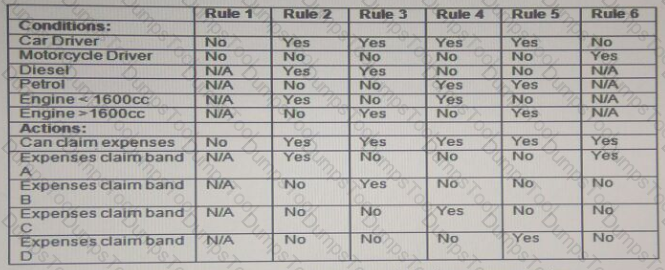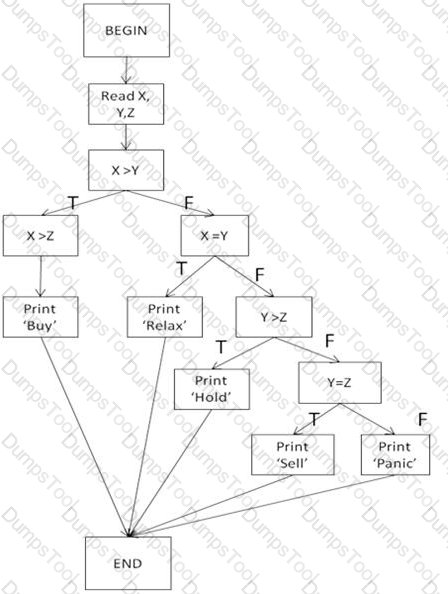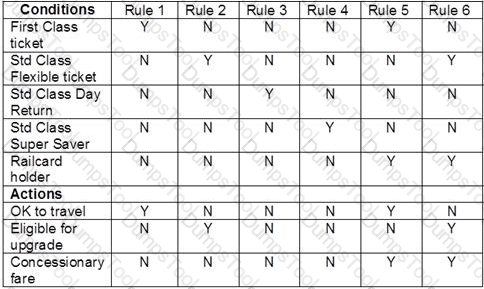
The decision table above shows a company's fuel expenses structure.
Which of the following Test Cases based on the decision table are Valid?
Test Case 1:
An employee who is not a car or motorcycle driver attempts to claim fuel expenses. Expected result: Expense claim not allowed.
Test Case 2:
An employee who drives a 1700cc diesel car attempts to claim fuel expenses. Expected result: Expense claim accepted at band C.
Test Case 3:
An employee who rides a motorcycle attempts to claim fuel expenses. Expected result: Expense claim accepted at band A.
Which of the following represents good testing practice for testers, irrespective of the software lifecycle model used?

In the above State Table, which of the following represents an invalid transition?
Debugging and Testing are key activities in the software development lifecycle.
Which of the following are 'Debugging' activities?
a) Identifying, a failure
b) Locating the cause of failure
c) Fixing the defect
d) Checking the fix has resolved the failure
Which of the following options explain why it is often beneficial to have an independent test function in an organisation?
You have been asked to improve the way test automation tools are being used in your company.
Which one of the following is the BEST approach?
A garden irrigation system allows the user to specify 2 inputs:
1. Frequency - The number of times the system should be automatically switched on per day; minimum once per day, maximum 5 times
2. Duration - The duration of operation, in whole minutes, each time it is switched on; ranging from 1 to 60
Applying 2-value boundary value analysis which of the following options has the correct test set of valid and invalid boundary values?
A system requirement states that up to 100 users should be able to carry out a transaction, with responses returned within 5 seconds.
What type of non-functional testing would you carry out to verify these requirements?
During the development of a software change for a system, the developer makes a mistake in his work, which leads to a fault in the code. Unfortunately the fault is not found by software testing and is released into live.
What is the definite consequence of this mistake?
A booking system for a city bus service prices its fares according to the time of travel:
• Peak-time tariff starts at 0600 and finishes at 1000 am
• Off-peak tariff applies during all other times of service
• The bus service does not operate between 2300 and the start of the next day’s peak service
Note that all times mentioned are inclusive.
When applying the equivalence partitioning test design technique, which of the following options, shows test case inputs that each fall into a different equivalence partition?
Testing effort can depend on a number of factors, which one of following is MOST likely to impact the amount of effort required?
When considering the roles of test leader and tester, which of the following tasks would NOT typically be performed by a tester?
A new testing tool has been selected for an organisation and a pilot project has successfully completed. The next step is to deploy the tool within the organization.
What is a key success factor in tool deployment?
Which of the following would you NOT expect to see on an incident report from test execution?
During which stage of the fundamental test process is the testability of requirements evaluated?
You are examining a document which gives the precise steps needed in order to execute a test.
What is the correct definition of this document?
Which of the following would NOT be a common metric used for monitoring test preparation and execution?
Which of the following is a defect that is more likely to be found by a static analysis tool than by other testing techniques?
Which of the following does NOT represent one of the three triggers for maintenance testing an operational system?

The decision table above reflects a golf club's pricing structure for green fees and buggy/cart hire.
What is the expected result (actions) for each of the following two test cases (TC1 and TC2)?
* TC 1 - Paul is not a full member, is a Loyalty Card holder and requests to play 18 holes with a buggy/cart
* TC 2 - Cheryl is not at full member, doesn't have a Loyalty Card and requests to play 9 holes with a buggy/cart
Which of the following activities is appropriate to the test planning stage?
A system is being enhanced to simplify screen navigation for users.
Which of the following does NOT reflect structural testing?
Which of the following BEST describes the relationship between test planning and test execution? [K2]
Which of the following correctly states a limitation in the use of static analysis tools? [K1]
Which of the following test design techniques is not a black box technique?
Which statement BEST describes when test planning should be performed? [K1]
Which from the following list are typically found to enable the review process to be successful? [K2]
a. Each review has clear defined objectives
b. The lower the number of defects, the better the review process
c. The right people for the review objective are involved
d. There is an emphasis on learning and process improvement
e. Management are not involved in the process at all
f. Checklists should not be used, as these slow down the process
g. Defects found are welcomed and expressed objectively
Which of the following test cases will ensure that the statement ‘Print ‘Hold’’ is exercised? [K3]
Refer to the exhibit

Which of the following would NOT be a typical target of testing support tools?
Which of the following processes ensures that all items of testware are identified, version controlled, tracked for changes, so that traceability can be maintained throughout the test process?
Which of the following characteristics is most likely to promote effective software testing? [K1]
Which of the following statements about software development models is most accurate? [K1]
Consider the following pseudo code
1. Begin
2. Read Gender
3. __Print “Dear”
4. If Gender = ‘female’
5. Print (“Ms”)
6. Else
7. __Print ( “Mr”)
8. Endif
9. End
How many test cases are needed to achieve 100 per cent decision coverage?
A system calculates the amount of customs duty to be paid:
_ No duty is paid on goods value up to, and including, $2,000.
_ The next $8,000 is taxed at 10%.
_ The next $20,000 after that is taxed at 12%.
_ Any further amount after that is taxed at 17%.
To the nearest $, which of these groups of numbers fall into three DIFFERENT equivalence classes?
Which of the following accurately defines the integration testing test level? [K2]
The Cambrian Pullman Express has special ticketing requirements represented by the partial decision table below.
Refer to the exhibit

Carol has a student railcard and is travelling on a Flexible Standard Class ticket. James has a senior railcard and is travelling on a super saver ticket. Which of the options represents the correct actions for these two test cases? [K3]
An iPhone application identifies and counts all purchases of a particular product from a shopping website. The application incorrectly counts purchase attempts by including both failed attempts, and also those where the purchase was terminated by the user before completion. Testing has identified that the problem was located in the ‘purchase identification’ module, where the first stage in the purchasing process was counted, rather than a successful confirmed purchase.
Which of the following statements correctly identifies what has happened? [K2]
Testers are often seen as the bearer of unwanted news regarding defects. What are effective ways to improve the communication and relationship between testers and others?
a)Communicate factual information in a constructive way.
b)Try to understand how the other person feels and why they react the way they do.
c)Always outsource testing activities.
d)Never record information that could be used to apportion blame to an individual or team.
Test script TransVal 3.1 tests transaction validation via screen TRN 003B. According to the specification (PID ver 1.3 10b iv) the validation screen should not accept future dated transactions. Test script TransVal 3.1 passes. Test script eod 1.4 tests end of day processing and is run after the execution of TransVal 3.1 using data entered during that test
Which of the following is the BEST detail on an incident report? [K3]
What factors should be considered to determine whether enough testing has been performed?
(i)The exit criteria.
(ii)The budget.
(iii)How big the test team is.
(iv)The product's risk profile.
(v)How good the testing tools are.
(vi)Sufficient details of the system status to allow decisions
Which of the following metrics could be used to monitor progress along with test preparation and execution? [K1]
Which of the following are most characteristic of structure-based testing?
(i) Information about how the software is constructed is used to derive test cases.
(ii) Statement coverage and/or decision coverage can be measured for existing test cases.
(iii) The knowledge and experience of people are used to derive test cases.
(iv) Test cases are derived from a model or specification of the system.
Which of the following could be a reason for a failure?
1) Testing fault
2) Software fault
3) Design fault
4) Environment Fault
5) Documentation Fault
Consider the following statements about early test design:
i. Early test design can prevent fault multiplication
ii. Faults found during early test design are more expensive to fix
iii. Early test design can find faults
iv. Early test design can cause changes to the requirements
v. Early test design takes more effort
Which of the following is most likely to be a benefit of using static techniques?
Which of the following describes structure-based (white-box) test case design techniques?
The five parts of the fundamental test process have a broad chronological order. Which of the options gives three different parts in the correct order?
Which activities form part of test planning?
i) Developing test cases.
ii) Defining the overall approach to testing.
iii) Assigning resources.
iv) Building the test environment.
v) Writing test conditions.
Test Implementation and execution has which of the following major tasks?
i. Developing and prioritizing test cases, creating test data, writing test procedures and optionally preparing the test harnesses and writing automated test scripts.
ii. Creating the test suite from the test cases for efficient test execution.
iii. Verifying that the test environment has been set up correctly.
iv. Determining the exit criteria.
To test a function, the programmer has to write a _________, which calls the function to be tested and passes it test data:
Which of the following statements are TRUE? A. Regression testing and acceptance testing are the same. B. Regression tests show if all defects have been resolved. C. Regression tests are typically well-suited for test automation. D. Regression tests are performed to find out if code changes have introduced or uncovered defects. E. Regression tests should be performed in integration testing.
Which of the following is the main purpose of the component build and integration strategy?
A software component has the code shown below:
Program BiggestA,
Biggest: Integer
Begin
Read A
Biggest = 10
While A > 0
Do
If A > Biggest
Then Biggest = A
Endif
Read A
Enddo
End
The component has exit criteria for component testing that include 100% statement coverage. Which of the following test cases will satisfy this criterion?
Which of the following is most likely to cause failure in the implementation of a test tool?
Which of the following are valid justifications for developers testing their own code during unit testing?
(i) Their lack of independence is mitigated by independent testing during system and acceptance testing.
(ii) A person with a good understanding of the code can find more defects more quickly using white-box techniques.
(iii) Developers have a better understanding of the requirements than testers.
(iv) Testers write unnecessary incident reports because they find minor differences between the way in which the system behaves and the way in which it is specified to work.